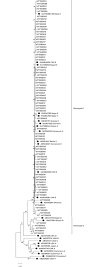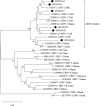Seroprevalence and molecular characterization of viral hepatitis and HIV co-infection in the Central African Republic
- PMID: 38722944
- PMCID: PMC11081248
- DOI: 10.1371/journal.pone.0291155
Seroprevalence and molecular characterization of viral hepatitis and HIV co-infection in the Central African Republic
Abstract
Background: The Central African Republic (CAR) is one of the countries with the highest prevalence of viral hepatitis infection in the world. Coinfection with HIV increases the morbidity and mortality beyond that of mono-infection with either hepatitis or HIV. The present study describes the geographic distribution of viral hepatitis infections and molecular characterization of these viruses in the CAR.
Methodology: Out of 12,599 persons enrolled during the fourth Multiple Indicator Cluster Survey of 2010 in the CAR, 10,621 Dried Blood Spot (DBS) samples were obtained and stored at -20°C. Of these DBS, 4,317 samples were randomly selected to represent all regions of the CAR. Serological tests for hepatitis B, D, and C viruses were performed using the ELISA technique. Molecular characterization was performed to identify strains.
Results: Of the 4,317 samples included, 53.2% were from men and 46.8% from women. The HBsAg prevalence among participants was 12.9% and that HBc-Ab was 19.7%. The overall prevalence of HCV was 0.6%. Co-infection of HIV/HBV was 1.1% and that of HBV/HDV was 16.6%. A total of 77 HBV, 6 HIV, and 6 HDV strains were successfully sequenced, with 72 HBV (93.5%) strains belonging to genotype E and 5 (6.5%) strains belonging to genotype D. The 6 HDV strains all belonged to clade 1, while 4 recombinants subtype were identified among the 6 strains of HIV.
Conclusion: Our study found a high prevalence of HBV, HBV/HDV and HBV/HIV co-infection, but a low prevalence of HCV. CAR remains an area of high HBV endemicity. This study's data and analyses would be useful for establishing an integrated viral hepatitis and HIV surveillance program in the CAR.
Copyright: © 2024 Basimane-Bisimwa et al. This is an open access article distributed under the terms of the Creative Commons Attribution License, which permits unrestricted use, distribution, and reproduction in any medium, provided the original author and source are credited.
Conflict of interest statement
The authors have declared that no competing interests exist.
Figures




References
-
- Papastergiou V, Lombardi R, MacDonald D, Tsochatzis EA. Global epidemiology of hepatitis B virus (HBV) infection. Curr Hepat Rep 2015;14:171–8. 10.1007/s11901-015-0269-3. - DOI
-
- WHO. World Health Organization. Global Hepatitis Report. 2017a. Glob Hepat Program Dep HIV/AIDS; 2017;Disponível:14.
Publication types
MeSH terms
LinkOut - more resources
Full Text Sources
Medical

